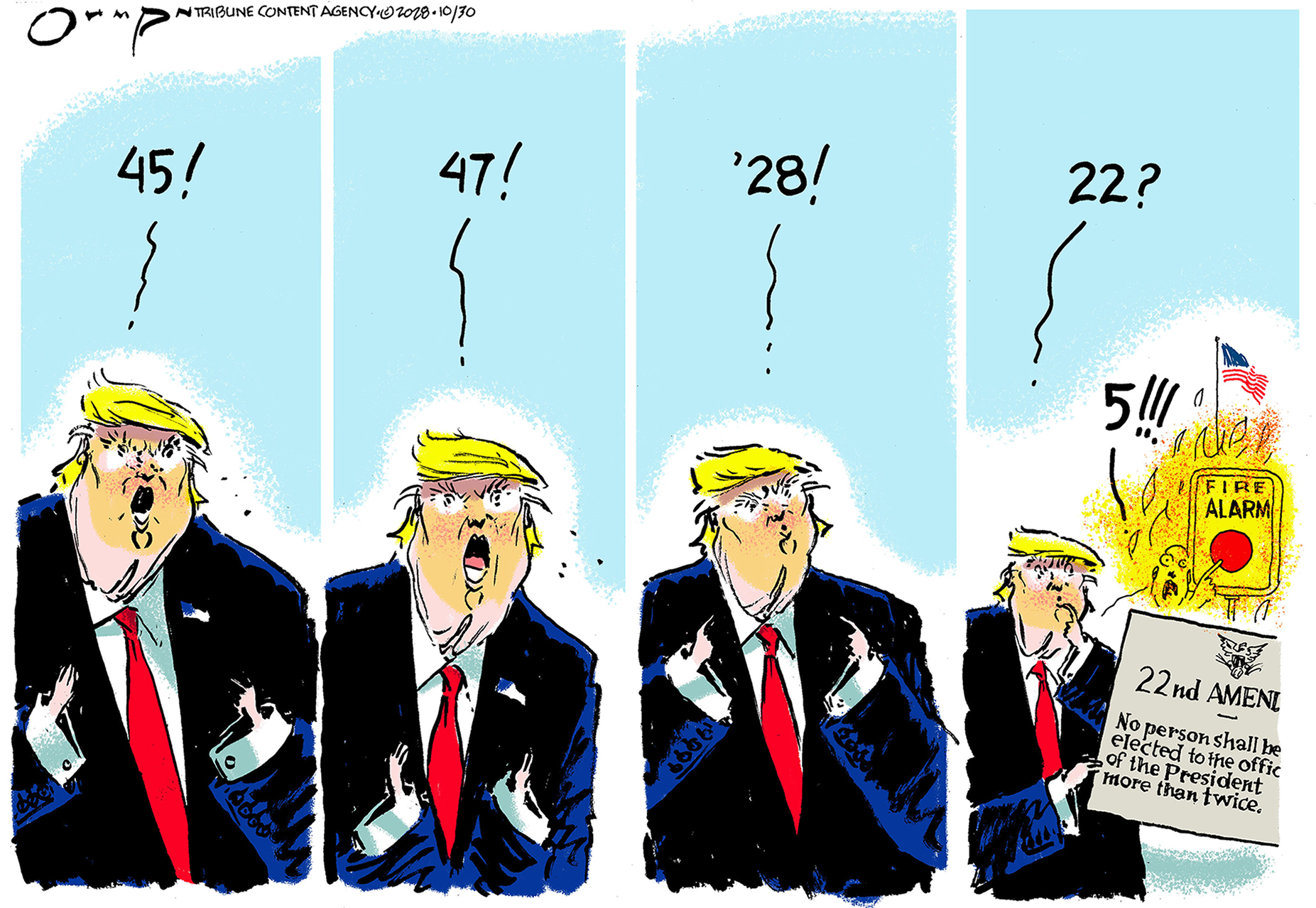If I produced election night coverage
Imagining some must-have graphics


This is an assignment memorandum for the producers of election night coverage. I feel I am modestly qualified to make these assignments because of my past experience covering politics at the network level, and because this year, I might well be — for the first time — a viewer.
The great gadgets and graphics and gimmicks are fun to watch.
But there are a couple of dynamic data points that everyone who has followed the race closely and those who are just tuning it for the drama will want to know.
The Week
Escape your echo chamber. Get the facts behind the news, plus analysis from multiple perspectives.

Sign up for The Week's Free Newsletters
From our morning news briefing to a weekly Good News Newsletter, get the best of The Week delivered directly to your inbox.
From our morning news briefing to a weekly Good News Newsletter, get the best of The Week delivered directly to your inbox.
The three Big Stories of the night are obvious: Will Obama get re-elected? Will Republicans take control of the Senate? Will they hang on to the House?
If I were producing the coverage, I'd make sure that, at all times in the lower third of the screen space, we'd have a graphic showing the current and projected advantage for Republicans in the House and Democrats in the Senate. These numbers ought to be automatically updated to reflect new projections. That is, let's say that it's 9:00 p.m. ET, and based on the races that have been called and projected so far, Democrats are clinging to a one-seat Senate majority. Right now, Democrats have a four-seat edge (two independents caucusing as Democrats, the vice presidential tie breaker, and 51 seats to their name). So the two data points that could be useful right at that moment would show the current composition (53) and the projected composition (51). But the more accurate graphic would show how many seats Republicans need to win to flip the chamber. And that's four, not three. So producers: Your graphic should look something like this. It should be on screen at all times, or rotated with the House control graphic, which I'll describe next.
U.S. SENATE
NOW: D +4
A free daily email with the biggest news stories of the day – and the best features from TheWeek.com
PROJECTED: D+2
The House graphics are a bit more complicated. Republicans control 242 seats and Democrats control 193. But this tells the casual viewer very little. Republicans have a 25-seat advantage in the House. So the House graphic would read:
NOW: R+25
PROJECTED: R+12
The font would be slightly different for the projected make-up, and it would attest to its dynamic status. Since polls in Hawaii and Alaska don't close until very late, networks have to use projections. What makes the second part of the graphic interesting is that it can be updated in real-time to reflect House projections and real-vote returns that come in. (All networks use essentially the same computer back-end to crunch the numbers; their projection models differ slightly based on the political scientists and analysts who serve on the decision desks.) As the PROJECTED number is updated, it can flash — and anchors/reporters can explain (briefly) why the projection has changed, and perhaps the races that have been called can also flash on the screen. The graphic does not perfectly correspond to the 435 individual House elections because some can't be called even though the winner might be obvious. But the computer models will take the safe seats into account and the human modelers will make responsible projections.
Now, to the presidency. The magic number is 270 electoral votes. There are two ways to handle this. One is to simply show the projected electoral votes for each candidate in real-time.
CURRENT EV (269 NOT CALLED)
ROMNEY + 145
OBAMA + 124
Another would show how many EVs are needed.
TO WIN (300 of 538 NOT CALLED)
ROMNEY needs 100
OBAMA needs 29
Another rotating graphic could show SCENARIOS to victory. They'd be in shorthand:
ROMNEY'S PATH NOW: WINNING OH, CO, NV, AND NM
OBAMA'S PATH NOW: WINNING CO AND NV, OR IA AND NV
But here's where networks can get creative.
They'll have data to show where lies the outstanding vote, and in each state, it is fairly easy to write a formula that allows an anchor to say something like: "In Ohio, about 14,000 votes separate President Obama from Mitt Romney, but Romney needs to win about 56 percent of the outstanding precincts — precincts that tend to give Republicans 60 percent of their vote. So Ohio looks good for Romney, based on the turnout models that we have."
On screen, you'd see:
OHIO (18 EVs)
OBAMA: 392,303 — 52 percent
ROMNEY: 378,304 — 48 percent
Margin: 14,000
Precincts reporting: 43 percent
Tilt to precincts not yet reporting: 60 percent GOP
-----------------
At this point, John King, Chuck Todd, and their maps can go to town. But rarely do networks actually quantify the projected outstanding vote in states, and I don't know why. They have the data (I've seen it), and it anchors the drama of the night in reality.
The exit poll data and the real-vote tracking ability of the networks is truly awesome on election night, and for the sake of viewers, I think it ought to be incorporated into the graphical crawls more easily.
Technically, there are no impediments. But producers need to think through these things in advance as they figure out how to tell the story on election night, a story that is largely numerical.
Marc Ambinder is TheWeek.com's editor-at-large. He is the author, with D.B. Grady, of The Command and Deep State: Inside the Government Secrecy Industry. Marc is also a contributing editor for The Atlantic and GQ. Formerly, he served as White House correspondent for National Journal, chief political consultant for CBS News, and politics editor at The Atlantic. Marc is a 2001 graduate of Harvard. He is married to Michael Park, a corporate strategy consultant, and lives in Los Angeles.
-
 Eel-egal trade: the world’s most lucrative wildlife crime?
Eel-egal trade: the world’s most lucrative wildlife crime?Under the Radar Trafficking of juvenile ‘glass’ eels from Europe to Asia generates up to €3bn a year but the species is on the brink of extinction
-
 Political cartoons for November 2
Political cartoons for November 2Cartoons Sunday's political cartoons include the 22nd amendment, homeless camps, and more
-
 The dazzling coral gardens of Raja Ampat
The dazzling coral gardens of Raja AmpatThe Week Recommends Region of Indonesia is home to perhaps the planet’s most photogenic archipelago.
-
 Millions turn out for anti-Trump ‘No Kings’ rallies
Millions turn out for anti-Trump ‘No Kings’ ralliesSpeed Read An estimated 7 million people participated, 2 million more than at the first ‘No Kings’ protest in June
-
 Ghislaine Maxwell: angling for a Trump pardon
Ghislaine Maxwell: angling for a Trump pardonTalking Point Convicted sex trafficker's testimony could shed new light on president's links to Jeffrey Epstein
-
 The last words and final moments of 40 presidents
The last words and final moments of 40 presidentsThe Explainer Some are eloquent quotes worthy of the holders of the highest office in the nation, and others... aren't
-
 The JFK files: the truth at last?
The JFK files: the truth at last?In The Spotlight More than 64,000 previously classified documents relating the 1963 assassination of John F. Kennedy have been released by the Trump administration
-
 'Seriously, not literally': how should the world take Donald Trump?
'Seriously, not literally': how should the world take Donald Trump?Today's big question White House rhetoric and reality look likely to become increasingly blurred
-
 Will Trump's 'madman' strategy pay off?
Will Trump's 'madman' strategy pay off?Today's Big Question Incoming US president likes to seem unpredictable but, this time round, world leaders could be wise to his playbook
-
 Democrats vs. Republicans: who are US billionaires backing?
Democrats vs. Republicans: who are US billionaires backing?The Explainer Younger tech titans join 'boys' club throwing money and support' behind President Trump, while older plutocrats quietly rebuke new administration
-
 US election: where things stand with one week to go
US election: where things stand with one week to goThe Explainer Harris' lead in the polls has been narrowing in Trump's favour, but her campaign remains 'cautiously optimistic'
